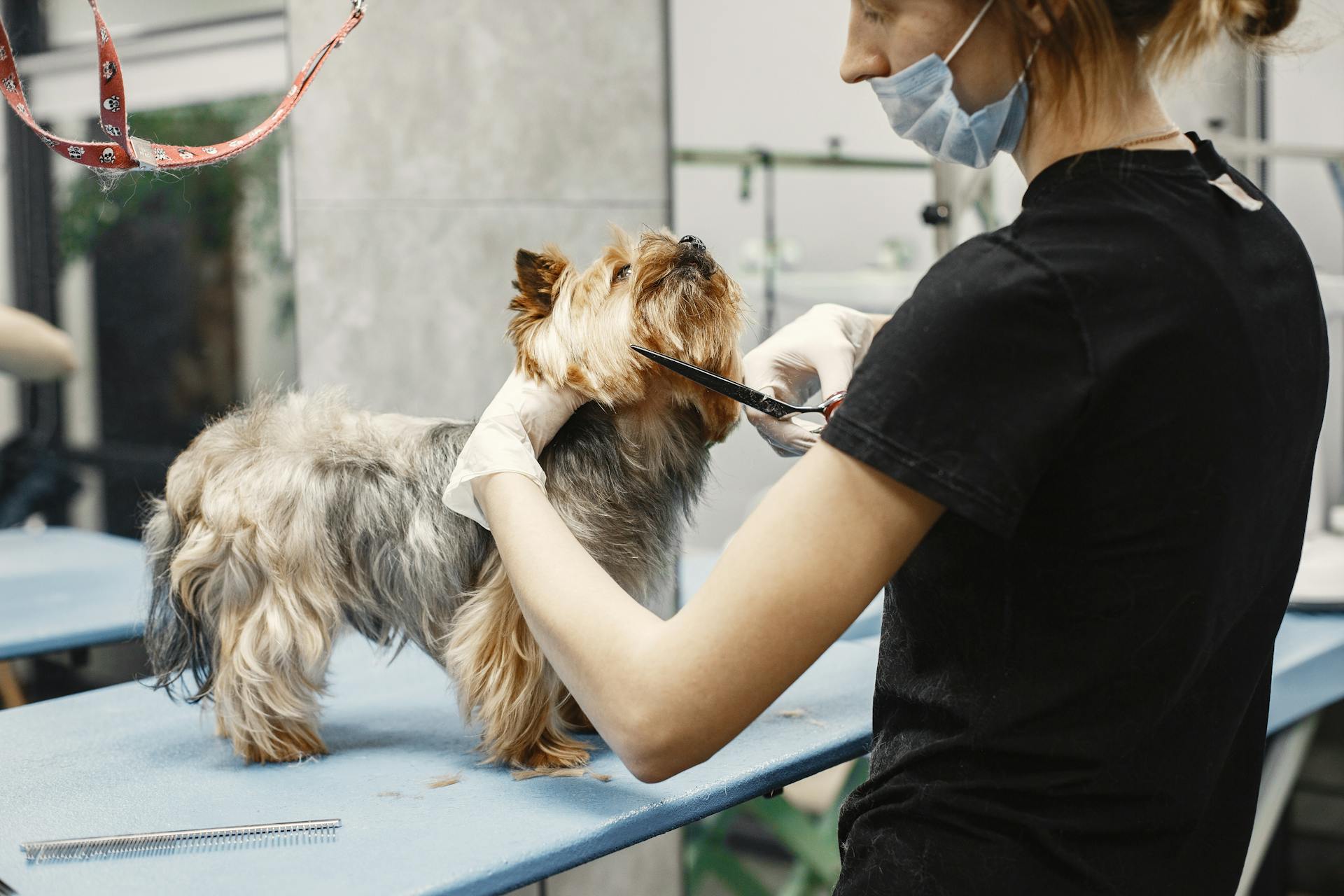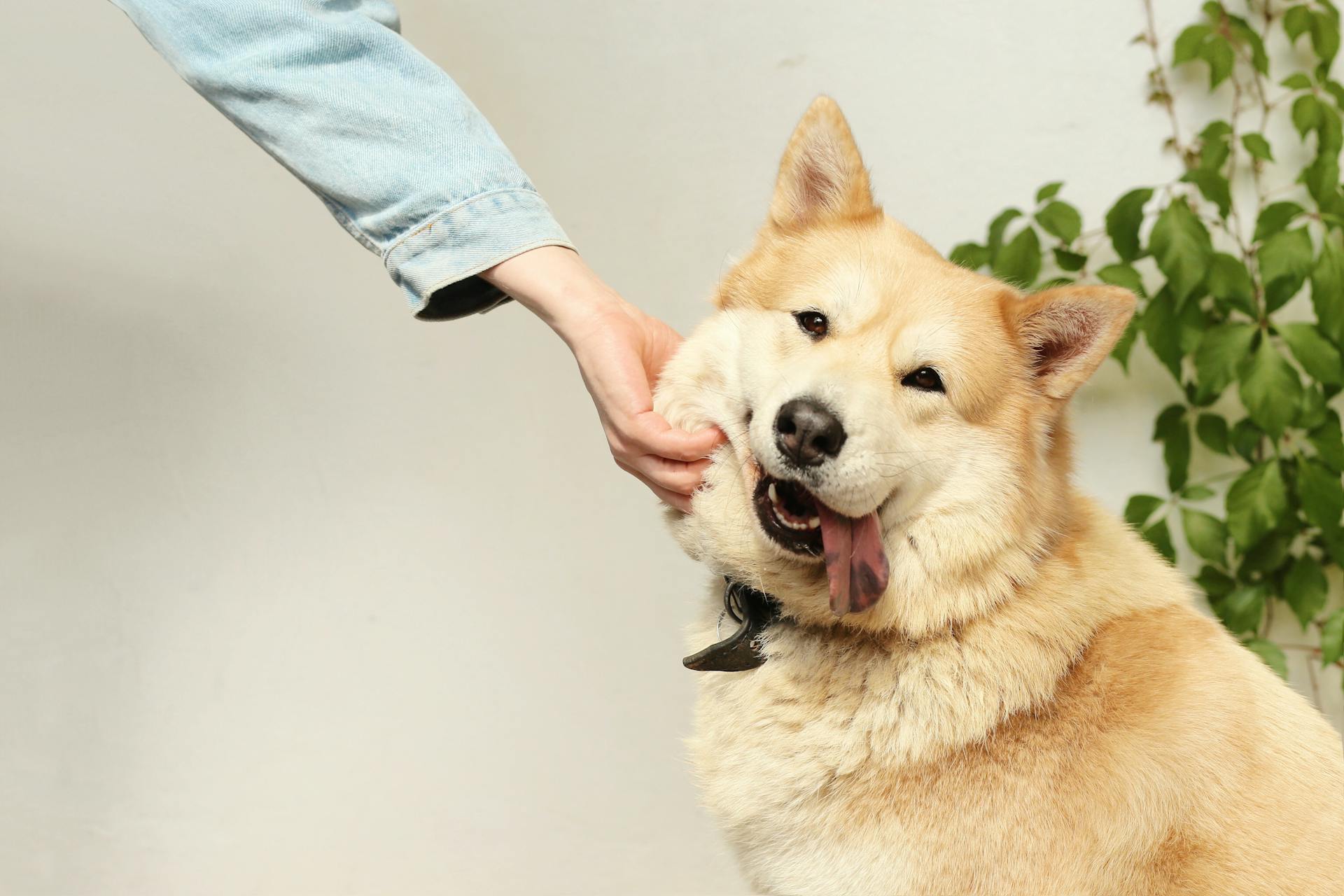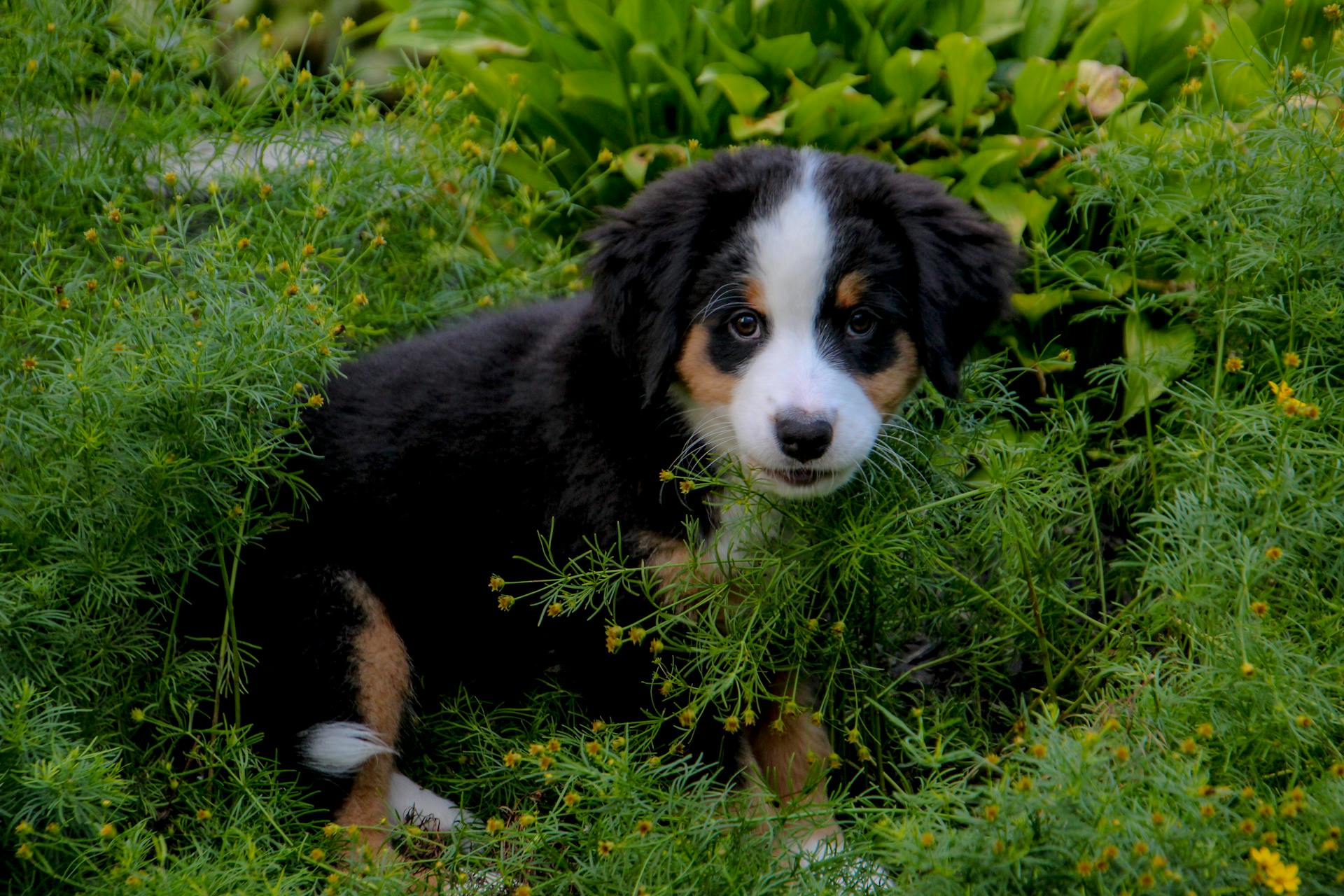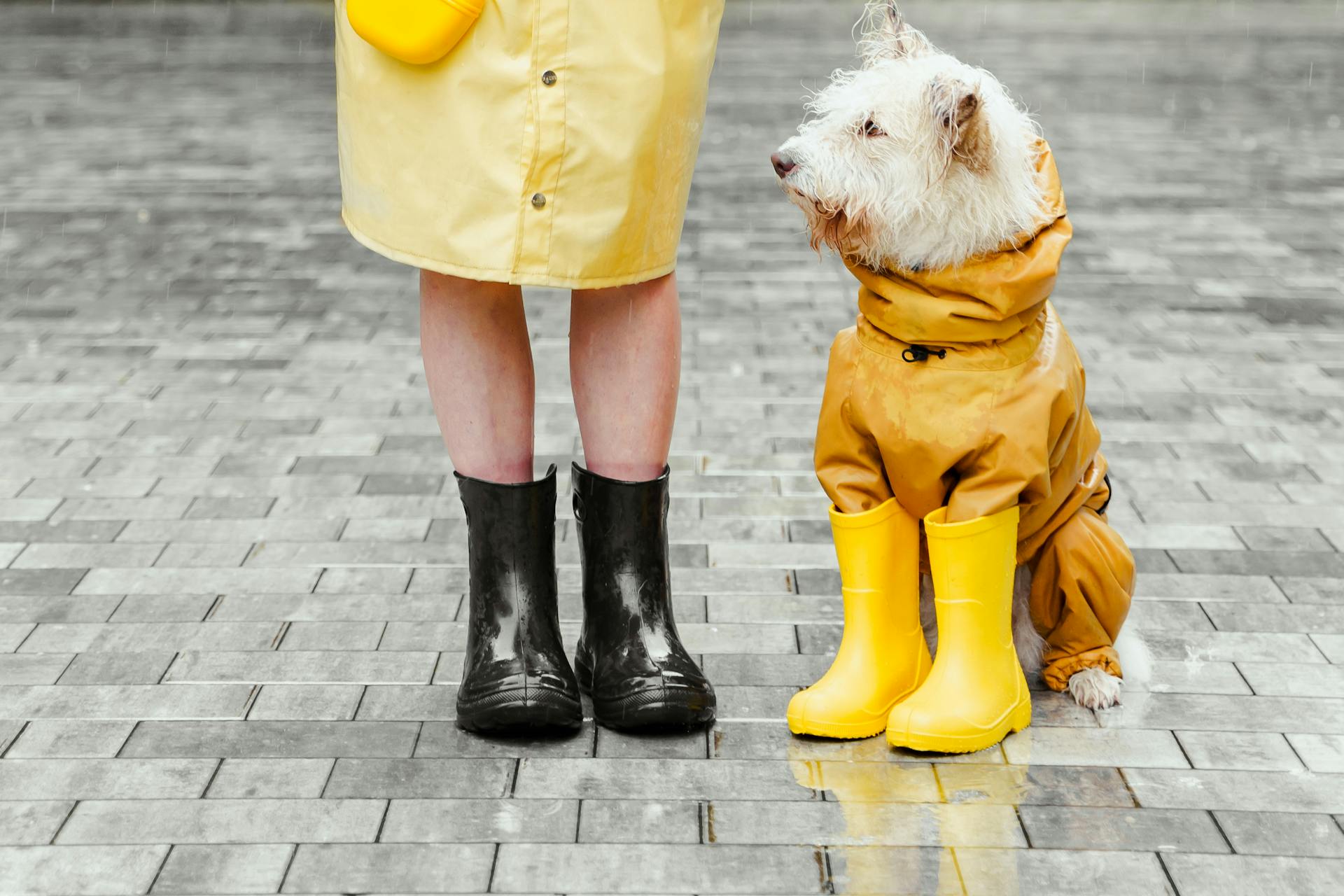
Grooming a Bernedoodle at home can be a bit of a challenge, but with the right tools and knowledge, it can also be a great bonding experience for you and your furry friend.
Bernedoodles require regular grooming to prevent matting and tangling of their fur, which can be painful and even lead to skin infections.
Their thick coat sheds heavily, especially during shedding season, so it's essential to brush them daily to prevent matting and tangling.
The ideal brush for a Bernedoodle is a slicker brush, which is designed to remove tangles and mats without causing breakage or pain to the dog.
Daily brushing can also help reduce shedding and prevent hair from getting everywhere in your home.
You might enjoy: Best Brush for a Cavapoo
Benefits of Regular Grooming
Regular grooming is essential for keeping your Bernedoodle healthy and comfortable. It helps maintain a clean and healthy coat by removing dirt, debris, and dead hair to prevent mats and tangles.
Regular grooming sessions can minimize shedding around your home, especially during shedding seasons when Bernedoodles tend to lose more fur. By brushing your Bernedoodle regularly, you can reduce the amount of loose hair.
Brushing and detangling prevent mats from forming in the long and thick coat of Bernedoodles, making it uncomfortable for your dog. Mats may require professional grooming to remove, which can be stressful for your dog.
Regular grooming promotes healthy skin by allowing you to closely inspect your Bernedoodle's skin for irritation, dryness, or parasites like fleas or ticks. This helps you address any issues promptly and keep your dog's skin healthy.
Regular grooming sessions also provide an opportunity to bond with your Bernedoodle, allowing you to spend quality time together and enhance your relationship and trust.
For another approach, see: Mats Dog Grooming
Understanding Bernedoodles
Understanding Bernedoodles requires a grasp of their unique coat characteristics. Their coat combines the Poodle's curly or wavy hair with the Bernese Mountain Dog's straight or wavy fur, resulting in varying textures and lengths.
Regular brushing is crucial to prevent matting and tangles, and it's recommended to brush your Bernedoodle's coat at least three times a week. This will help keep their coat healthy and free from debris.
Some Bernedoodles may possess hypoallergenic coats, which make them more suitable for individuals with allergies. However, reactions may vary, so it's essential to understand your Bernedoodle's coat type to select the right grooming tools and products.
Discover more: Bernedoodles and Goldendoodles
Understanding a Breed
Understanding a Bernedoodle's coat is crucial for their overall health and happiness. The coat is a combination of the Poodle's curly or wavy hair and the Bernese Mountain Dog's straight or wavy fur, resulting in varying textures and lengths.
Regular brushing is essential to prevent matting and tangles, and it's recommended to brush their coat at least three times a week. This will help keep their coat healthy and free from debris.
Some Bernedoodles may have hypoallergenic coats, making them a great option for people with allergies. However, it's essential to note that not all Bernedoodles are hypoallergenic, and reactions may vary.
While Bernedoodles may shed less than some breeds, they still require regular grooming to maintain their coat's health and appearance. Depending on the coat type, professional grooming services may be necessary every 6-8 weeks.
To properly care for your Bernedoodle's coat, it's essential to understand their specific coat type and needs. This will help you select the right grooming tools and products, such as combs, brushes, and shampoos specifically designed for their coat type.
If this caught your attention, see: Bernedoodle Health Issues
Some Facts About Bernedoodles
Bernedoodles are a cross between a Bernese Mountain Dog and a Poodle, making them a hybrid breed. They typically weigh between 70-120 pounds and stand between 20-28 inches tall.
Their intelligence and trainability make them a popular choice as family pets and working dogs. They require regular grooming to prevent matting and tangling of their fur.
Bernedoodles are generally known for being friendly and outgoing, but they can also be wary of strangers. Socialization from an early age is crucial to help them feel comfortable around new people and environments.
Their intelligence also makes them prone to separation anxiety if left alone for extended periods without proper training and exercise.
Types of Bernedoodle Grooming
You can groom a Bernedoodle at home with the right tools and knowledge. Brushing is a must to prevent mats and tangles in your Bernedoodle's coat. Use a slicker brush or comb with wide-spaced teeth to remove loose hair and keep the coat neat.
Regular nail care is also essential to prevent discomfort and injuries. Trim your Bernedoodle's nails every 2-3 weeks to keep them from getting too long. Use a dog nail clipper and be careful not to cut too close to the quick.
Cleaning your Bernedoodle's ears is crucial to prevent infections. Use a dog ear cleaner and cotton balls to gently wipe away dirt or debris from their ears.
What Are the Types of?
The type of coat your Bernedoodle has will determine how much grooming it needs.
A curly coat is typically low-shedding and hypoallenic, requiring regular brushing to prevent matting and occasional professional grooming to maintain the desired length and shape.
Straight coats are easier to maintain, but still need regular brushing to prevent tangles and occasional grooming to trim the fur and keep it neat.
Wavy coats fall somewhere in between, requiring regular brushing to prevent matting.
Some Bernedoodles may have a double coat, with an outer coat and an undercoat. The outer coat is longer and coarser, while the undercoat is softer and provides insulation. Double-coated Bernedoodles may shed more and need more frequent brushing.
Here are the different coat types of Bernedoodles:
Understanding Types
A straight coat resembles the genetic influence of the Bernese mountain dog, and Bernedoodles with straight coats do shed a little.
Regular brushing is essential for a straight or wavy coated doodle to prevent tangles and matting, especially behind the ears and in the armpits.
You should never brush a dry coat, as it can cause breakage and damage. Always apply a light brushing mist to the coat before brushing to add slip and moisture.
Brushing a straight or wavy coated doodle requires a specific technique, known as "line brushing", where you brush the hair up the leg and then back down, working your way up the dog's body.
Many a groomer has had to shave down a dog because the owner thought it was mat-free, but in reality, there were knots underneath that had been missed.
Broaden your view: Brush for Bernedoodle
At-Home Grooming Essentials
To groom your Bernedoodle at home, you'll need the right tools. A slicker brush is a great tool to undo mats and tangles along Bernedoodle coats, and it's designed not to damage the coat.
You'll also need a wide-toothed comb to smoothen out your dog's fur, which helps to spread out the natural oils on the coat.
A nail clipper is essential for keeping your Bernedoodle's nails trimmed, and it's recommended to check them regularly to prevent long nails from becoming detrimental to their health.
Here are some essential at-home grooming tools for your Bernedoodle:
- Grooming Shears
- Slicker Brush
- Comb (wide-toothed)
- Nail Clippers
- Ear Cleaner
- Toothbrush and Toothpaste
- Shampoo (4-in-1 pack dog shampoos)
- Grooming Apron And Towels
- Styptic Powder
Essential Tools
Grooming is an essential part of caring for your Bernedoodle, and having the right tools makes all the difference.
Grooming shears are a must-have for trimming your Bernedoodle's fur, and stainless steel is the recommended material for sharpness and durability.
A slicker brush is a great tool for undoing mats and tangles in your Bernedoodle's coat, and it's designed not to damage the coat.
A wide-toothed comb is perfect for smoothening out your dog's fur and spreading out the natural oils in their coat.
Nail clippers are a must for regular nail trimming, and it's essential to check your dog's nails regularly to prevent health problems.
If this caught your attention, see: Do Havanese Have Hair or Fur
Ear cleaner is crucial for preventing ear infections by removing wax and debris, and cotton balls are a great tool for cleaning the outside of your dog's ears.
A dog-specific toothbrush and toothpaste are a must for maintaining your dog's dental hygiene.
A grooming table provides a stable platform for grooming your furry friend, and it's a great investment for making grooming easier and more comfortable.
A deshedding tool is a great way to minimize shedding, and it's essential for regular grooming.
Styptic powder is a must-have for stopping bleeding from accidental cuts during grooming.
Here is a list of the essential tools you'll need for at-home grooming:
- Grooming shears
- Slicker brush
- Comb (wide-toothed)
- Nail clippers
- Ear cleaner
- Toothbrush and toothpaste (dog-specific)
- Grooming table
- Deshedding tool
- Styptic powder
At-Home Grooming
At-home grooming is a great way to bond with your Bernedoodle and save money on professional grooming sessions. You can groom your Bernedoodle at home with the right tools and knowledge.
Regular brushing is essential to prevent mats and tangles in your Bernedoodle's coat. Use a slicker brush or comb with wide-spaced teeth to remove loose hair and keep the coat neat.
Bathing your Bernedoodle every 6-8 weeks or as needed is a must. Use a gentle dog shampoo and rinse thoroughly to avoid skin irritation.
Trimming the hair around your Bernedoodle's eyes, paws, and bottom is crucial for hygiene. Use grooming scissors or clippers with a guard for a neat appearance and your pet's safety.
You should brush your Bernedoodle's hair 2-3 times a week with a specialized dog brush, such as a slicker brush. This will help prevent matting and keep their coat healthy.
Here's a list of essential tools you'll need for at-home grooming:
- Grooming shears
- Slicker brush
- Comb
- Nail clippers
- Ear cleaner
- Toothbrush and toothpaste
- Grooming table
- Deshedding tool
- Styptic powder
Remember to approach grooming sessions with patience and reward your Bernedoodle with treats and praise for a positive experience. If you're unsure or uncomfortable, seek the help of a professional groomer.
Step-by-Step Guide
Brush your Bernedoodle's coat regularly to prevent mats and tangles. Use a slicker brush or comb with wide-spaced teeth to remove loose hair and keep the coat neat.
Brushing should be done daily, especially after playtime or walks when loose hair accumulates. This will help prevent mats and tangles from forming.
Bathing is necessary every 6-8 weeks or as needed, using a gentle dog shampoo and rinsing thoroughly to avoid skin irritation. Properly drying the coat prevents dampness and potential skin issues.
Trim the hair around your Bernedoodle's eyes, paws, and bottom for hygiene, using grooming scissors or clippers with a guard for a neat appearance and your pet's safety. This will also help prevent hair from getting into your Bernedoodle's eyes or causing irritation.
Regularly trim your Bernedoodle's nails to prevent discomfort and injuries, using a dog nail clipper and being careful not to cut too close to the quick. You can also use a nail grinder for a smoother finish.
Clean your Bernedoodle's ears to prevent infections, using a dog ear cleaner and cotton balls to gently wipe away dirt or debris. Also, use a damp cloth to wipe around the eyes and remove tear stains.
Approach grooming sessions with patience and reward your Bernedoodle with treats and praise for a positive experience. This will help your Bernedoodle associate grooming with positive reinforcement.
Consider reading: How to Cut Bernedoodle Hair
Brushing and Detangling
Brushing and detangling the coat of a Bernedoodle is crucial for their grooming routine. Regular brushing is vital as it helps to keep their coat clean, prevents matting, and maintains their overall health and appearance.
You'll want to use a slicker brush or wide-toothed comb to remove loose hair, tangles, and mats from the coat. These tools are ideal for the job.
Start the brushing process from the head and work your way towards the tail, making sure to brush in the direction of hair growth to avoid causing any discomfort. Pay extra attention to areas that are prone to matting, such as behind the ears, armpits, and hindquarters.
Gently separate any tangles or mats using your fingers before brushing. When brushing, focus on one small section at a time and use short, gentle strokes, remembering to brush all the way down to the skin.
If you come across a stubborn mat, consider using a dematting tool or seek professional assistance. It's essential not to force it out as it may cause discomfort.
Here's a quick checklist to keep in mind:
- Use a slicker brush or wide-toothed comb
- Start from the head and work towards the tail
- Brush in the direction of hair growth
- Pay extra attention to prone areas
- Use short, gentle strokes
- Don't force out stubborn mats
After brushing, double-check for any missed tangles or mats by running your hands through your Bernedoodle's coat to feel for areas that might need further attention.
Bathing Your
Bathing Your Bernedoodle is an essential part of their grooming routine. It's essential to bathe them only when they get very dirty, wet, or muddy, as frequent bathing can lead to dry skin, itching, and discomfort.
You'll want to use a dog-friendly shampoo, specifically designed for Bernedoodles, to avoid harsh chemicals that can irritate their skin. Some good brands can be found on Amazon.
Before bathing, brush your dog's hair to prevent matting and tangling. Keeping your dog calm is key to a successful bath. Fill the tub with lukewarm water and soak your dog thoroughly before adding the shampoo.
Work the shampoo into a nice lather and gently rub it into their fur, paying attention to their hind legs and front legs. Be cautious not to get water in their ears or eyes. A thorough rinse is crucial to remove all soap residue.
Use a conditioner specifically designed for Bernedoodles, especially if they have long hair or curly coats. Conditioner helps to moisturize and soften their coat.
After the bath, pat your dog dry with a towel to stop dripping, and let their hair air-dry for best results. A force dryer can also be used to dry them quickly, straighten their coat, and work out smaller tangles.
Here's a quick rundown of the bathing process:
- Fill the tub with lukewarm water
- Soak your dog thoroughly
- Add dog-friendly shampoo
- Work the shampoo into a lather and rub it into their fur
- Rinse thoroughly
- Use conditioner (if recommended)
- Pat dry with a towel
- Let their hair air-dry (or use a force dryer)
Trimming
Trimming is an essential part of Bernedoodle grooming, and it's crucial to do it regularly to prevent discomfort and movement issues. Regular hair and nail trimming keeps them clean, comfortable, and free from issues.
To trim your Bernedoodle's hair, start by brushing their coat to remove tangles or mats. This helps see the dog's shape for trimming. Use grooming scissors to trim hair around the face, ears, and paws, being cautious not to cut too close to the skin or whiskers.
For more insights, see: Trimming a Pomeranian Dog
Trimming the nails is also crucial, and it's best to use dog nail clippers or a pet-specific grinder. Only trim the tip of the nail, avoiding the sensitive quick. Long-haired breeds like Bernedoodles are prone to "danglers" in the hind area, so it's essential to trim the hair under the tail and around this area to prevent future problems.
Here are some popular Bernedoodle haircuts that involve trimming:
- Winter cut: keeps your pup cozy throughout the winter, but requires more frequent brushing, especially if your Bernedoodle has curly hair.
- Summer cut: is much shorter and requires very little brushing for a straight coat or wavy coat.
- Kennel cut: reduces the possibility of mats and tangles and is easy to maintain.
- Teddy bear cut: works best on curly and wavy hair and makes your Bernedoodle look like a teddy bear.
Remember, grooming is a bonding experience, and it's essential to learn how to do it correctly and make sure you have the proper tools and time to commit to your pup.
Nail Care and Ear Grooming
Clipping your Bernedoodle's nails every four to six weeks is essential to prevent pain and discomfort.
Using a proper dog nail clipper is crucial, as it will help you avoid cutting too close to the quick.
Long nails can cause a lot of pain, leading to incorrect walking and strain on your pet.
Investing in a high-quality nail grinder can make the process much easier and safer for your dog.
Regular ear cleaning with a dog-specific cleanser is necessary to prevent dirt and debris from building up.
Gently removing excess hair from your Bernedoodle's ears will also help keep them clean and healthy.
Be careful not to push anything into the ear canal, as this can be painful and potentially cause injury.
If this caught your attention, see: Ear Cropping for Cane Corso
Clip My Nails
Clipping your dog's nails is a must. It's essential to keep your dog's nails clipped every four to six weeks.
Long nails can cause a lot of pain, leading to incorrect walking and putting a strain on your pet. This can be prevented by clipping your dog's nails regularly.
Clipping too far can create open wounds and cause pain, so be cautious not to cut too close to the quick. Use a proper dog nail clipper for a safer experience.
Investing in a high-quality nail grinder can make the process much easier and safer for your dog.
Grooming a Dog's Ears
Grooming a Dog's Ears is an essential part of their overall care, and it's not as complicated as you might think.
First, you'll want to clean your dog's ears regularly with a dog-specific cleanser. This will help keep them free from dirt and wax buildup.
Be gentle when cleaning your dog's ears, and avoid pushing anything into the ear canal. This is especially important to prevent any potential harm or discomfort for your furry friend.
Cleaning your dog's ears regularly will also help prevent infections and other issues. It's a good idea to make ear cleaning a part of your dog's regular grooming routine.
Hair Types and Mats
Your Bernedoodle's coat is likely to be straight or wavy, requiring regular brushing to prevent tangles and mats. Brushing should be done in sections, starting at the bottom and working up, using a slicker or pin brush to create a line between the hair going up and down. This will help prevent missing knots underneath.
Explore further: Brushing a Cockapoo
Never brush a dry coat, as it can cause breakage and tangles. Instead, apply a light brushing mist to add slip and moisture, making it easier to brush through. I've seen many Bernedoodles with matted coats, and it's a nightmare to deal with.
Mats can be prevented by bi-weekly brushing, even if it's just one side at a time. When you hit a mat, use your fingers and/or cornstarch to gently work it apart from the base. If mats do form, it's often easier to clip them out rather than trying to pull them out, which can be painful for your Bernedoodle.
Hair Types
Bernedoodles can have different coat types, which are determined by genetics and can vary even within the same litter.
The main types of coats are curly, straight, wavy, and double coat. Curly coats are low-shedding and hypoallergenic, while straight coats shed the most.
Curly coats require regular brushing to prevent matting and occasional professional grooming to maintain the desired length and shape. Regular brushing is also essential for straight and wavy coats to prevent tangles and knots.
Explore further: Straight Hair Aussiedoodle
A wavy coat falls between curly and straight, and requires regular brushing to prevent matting. Double-coated Bernedoodles may shed more and need more frequent brushing.
Here are the main characteristics of each coat type:
To prevent matting and tangling, it's essential to brush your Bernedoodle regularly, especially behind the ears and in the armpits. Always apply a light brushing mist to the coat before brushing to add slip and moisture and prevent breakage.
Mats
Mats can be a real pain to deal with, but they're a common issue many of us face with our furry friends. Mats are small tangles that grow into big knots if not taken care of.
It's essential to brush your dog regularly to prevent mats from forming. Bi-weekly brushing is a good rule of thumb, and even a quick once-over can make a big difference.
When you do encounter a mat, it's best to use your fingers and a little corn starch to gently pull it apart from the base. This can be done with a pin brush or a slicker brush if the mat is particularly stubborn.
Keep your fingers on the root section attached to the skin to avoid tugging at the root, which can be painful for your dog. If the mat is really difficult to work through, you can use a Safari mat cutter, but only for this purpose.
If you haven't been keeping up with your brushing, it's best to brush your dog completely through before a bath and then again as you blow them dry. Clipping the coat should only be done on a clean coat to avoid clipper marks.
Don't wash a matted dog, as the mats will tighten in water. And if you notice any yellow or green discharge, it's likely a sign of an infection, so be sure to bring your dog to the vet for treatment.
Frequently Asked Questions
What is the best haircut for a Bernedoodle?
The best haircut for a Bernedoodle is the Lamb Cut, ideal for hot summer months with minimal grooming needs. This cut is perfect for busy owners who want a low-maintenance look.
What do you brush Bernedoodles with?
For Bernedoodles, a long pin wood brush is recommended for dematting and detangling, making it ideal for effortless grooming at home.
Sources
Featured Images: pexels.com


